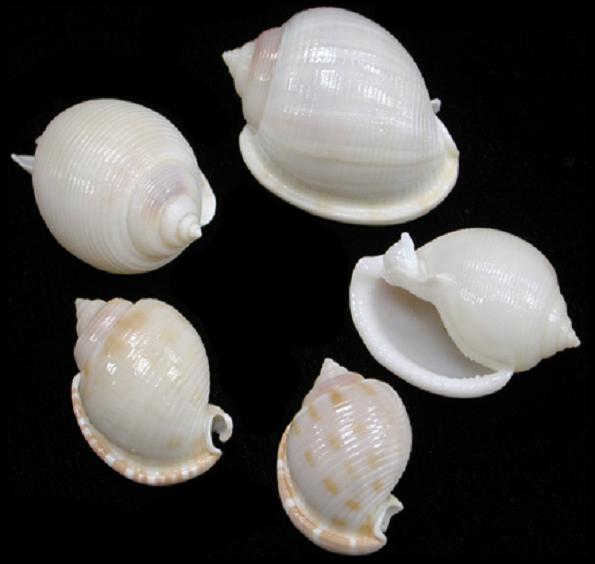Semicassis Granulata/Bonnet Shells

Semicassis granulata common name Scotch bonnet
Scotch bonnet (Semicassis granulata) is a medium-sized to large species of sea snail, a marine gastropod mollusk in the subfamily Cassinae, the helmet shells and bonnet shells. The common name "Scotch bonnet" alludes to the general outline and color pattern of the shell, which vaguely resemble a tam o' shanter, a traditional Scottish bonnet or cap.
This species lives intertidally and subtidally on sandy substrates, and is dwells primarily in the tropical and subtropical Western Atlantic Ocean, from North Carolina to Uruguay. There are published records of the nominate subspecies Semicassis granulata from several warm-water and tropical areas of the Western Atlantic Ocean. Species of this family occur in tropical and temperate seas from the intertidal zone to depths of 330 feet, buried in the sand during the day and becoming active at night. The Scotch bonnet are considered the most common species of Cassinae in North America.
The Cassidae are a taxonomic family of medium-sized, large, and sometimes very large sea snails commonly called helmet snails or bonnet snails. These are marine gastropod mollusks in the superfamily Tonnoidea and the clade Littorinimorpha; about 60 species comprise the family Cassidae. The average size of an adult shell varies between 1 1/3 to 5 inches. In the spring, the adult females of this species lay eggs in tower-shaped structures. The eggs hatch as veliger larvae, which can float in the plankton for up to 14 weeks before settling onto the seabed as tiny snails.
(REF:Gofas, S. (2010). Cassidae. In: Bouchet, P.; Gofas, S.; Rosenberg, G. (2010) World Marine Mollusca database. Accessed through: World Register of Marine Species) (REF: Phalium areola". Gastropods.com.) (REF: Kempf, S.C.; Hadfield, M.G. (1985). "Planktotrophy by the lecithotrophic larvae of a nudibranch, Phestilla sibogae (Gastropoda)". The Biological Bulletin. 169)
Members of the Cassidae family are shaped rather like bonnets or helmets, as their common name suggests. The shells are large, thick, subglobular with dextrally coiled, sometimes varicose, whorls, and a short spire. The coiling may be trochospiral or convoluted. The shells have great variability, which has led to many misidentifications, resulting in many synonyms.
Many of these species have a large and solid shield over the parietal body or beside the thick, plicated columella. Many species show blunt knobs and thickened axial ridges, known as varices. The thin, horny operculum is oval in shape and covers a long aperture. The siphonal canal is straight or slightly curved. The outer lip is somewhat thicker at its margin and toothed on the inside.
(REF: Gofas, S. (2010). Cassidae. In: Bouchet, P.; Gofas, S.; Rosenberg, G. (2010) World Marine Mollusca database. Accessed through: World Register of Marine Species
These snails have a large mantle and a large, muscular foot. Their large head has an extensible snout. The eyes are at the base of the single pair of tentacles.
Scotch bonnets prey on echinoderms (especially sea urchins), starting by gripping them using their foot. The snail then makes a hole in the urchin through the combined action of a secretion which is rich in sulfuric acid and by rasping with their radula. The acid secretion is provided by two large proboscis glands.
Crabs are a predator of this sea snail.
(REF: Hughes, RN | Hughes, HPI, Morphological and Behavioural Aspects of Feeding in the Cassidae (Tonnacea, Mesogastropoda) ; Malacologia. Vol. 20, no. 2)
The radula is an anatomical structure used by mollusks for feeding, sometimes compared to a tongue. It is a minutely toothed, chitinous ribbon, which is typically used for scraping or cutting food before the food enters the esophagus. The radula is unique to the mollusks, and is found in every class of mollusk except the bivalves, which instead use cilia, waving filaments that bring minute organisms to the mouth.
(REF: "Radula definitions". wordswarm.net. )
A proboscis is an elongated appendage from the head of an animal, either a vertebrate or an invertebrate. In invertebrates, the term usually refers to tubular mouthparts used for feeding and sucking. In vertebrates, a proboscis is an elongated nose or snout.
(REF: Henry George Liddell, Robert S, A Greek–English Lexicon, on Perseus Digital Library)
Scientific classification
Domain: Eukaryota
Kingdom: Animalia
Phylum: Mollusca
Class: Gastropoda
Subclass: Caenogastropoda
Order: Littorinimorpha
Family: Cassidae
Genus: Semicassis
Species: S. granulata
Binomial name: Semicassis granulata
(Born, 1778) (REF: Born, I. (1778). Index Rerum Naturalium Musei Caesarei Vindobonensis. Pars I. Testacea. )
Z1-7
One Scotch Bonnet shell 1 to 2 inches..... OUT OF STOCK